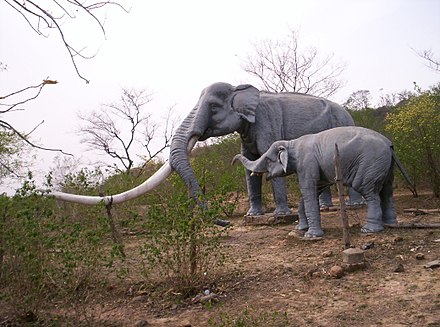Stegodon
Stegodon, meaning "roofed tooth" (from the Ancient Greek words στέγω, stégō, 'to cover', + ὀδούς, odoús, 'tooth') because of the distinctive ridges on the animal's molars, is a genus of the extinct subfamily Stegodontinae of the order Proboscidea. It was assigned to the family Elephantidae (Abel, 1919), but has also been placed in the Stegodontidae (R. L. Carroll, 1988).[1] Stegodonts were present from 11.6 million years ago (Mya) to the late Pleistocene, with unconfirmed records of localized survival until 4,100 years ago. Fossils are found in Asian and African strata dating from the late Miocene; during the Pleistocene, they lived across large parts of Asia and East and Central Africa, and in Wallacea as far east as Timor.[1][2][3]
A review of 130 papers written about 180 different sites with proboscidean remains in southern China revealed Stegodon to have been more common than Asian elephants; the papers gave many recent radiocarbon dates, the youngest being 2,150 BCE (4,100 BP).[2] However, Turvey et al. (2013) reported that one of the faunal assemblages including supposed fossils of Holocene Stegodon (from Gulin, Sichuan Province) is actually late Pleistocene in age; other supposed fossils of Holocene stegodonts were lost and their age cannot be verified. The authors concluded that the latest confirmed occurrences of Stegodon from China are from the late Pleistocene, and that its Holocene survival cannot be substantiated.[4]
Stegodon was one of the largest proboscideans, along with more derived genera. S. zdanskyi is known from an old male (50-plus years old) from the Yellow River that is 3.87 m (12.7 ft) tall and would have weighed approximately 12.7 tonnes (12.5 long tons; 14.0 short tons) in life. It had a humerus 1.21 m (4.0 ft) long, a femur 1.46 m (4.8 ft) long, and a pelvis 2 m (6.6 ft) wide.[5] Size varies across species, large stegodonts are comparable in size with modern elephants. Aside from S. zdanskyi, species like S. ganesha, S. miensis, S. orientalis, S. elephantoides and S. kaisensis are also relatively large bodied. Large stegodonts usually occur in the mainland. There also exist medium sized stegodonts present in large islands like those of Japan and Java. These stegodonts may include: S. aurorae, S. trigonocephalus, S. insignis and S. florensis florensis. Stegodonts that live in smaller islands usually result in further dwarfism.
S. florensis insularis is an extinct subspecies of Stegodon endemic to the island of Flores, Indonesia, and an example of insular dwarfism. The direct ancestor of S. florensis insularis is the larger-bodied S. florensis florensis, from Early Pleistocene and early Middle Pleistocene sites on Flores.[6] Remains of S. florensis insularis are known from the cave of Liang Bua.




